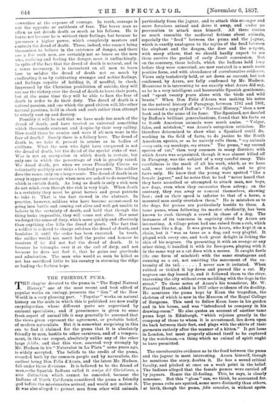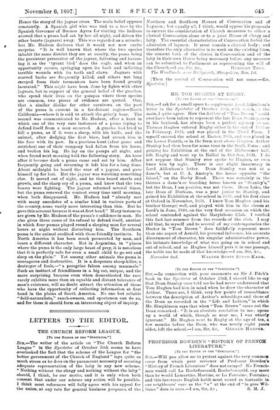THE FRIENDLY PUMA.
THE chapter devoted to the puma in "The Royal Natural History," one of the most recent and best edited of popular works on zoology, presents the " lion " of the New World in a very pleasing part. " Popular " works on natural history on the scale in which this is published are now really encyclopmdias, whose different parts are supervised by eminent specialists ; and if prominence is given to some fresh aspect of animal life it may generally be assumed that the views given represent the agreement, or probable belief, of modern naturalists. But it is somewhat surprising in this era to find it claimed for the puma that it is absolutely friendly to man, hostile to other carnivora, and of a tempera- ment, in this one respect, absolutely unlike any of the other large feuds', and that this view, asserted very strongly by Mr. Hudson in his "Naturalist in La Plata" some years ago, is widely accepted. The beliefs to the credit of the puma, recorded both by the common people and by naturalists, the earliest being Don Felix d'Azara, and the latest Mr. Hudson, fall under three divisions. It is believed to be the friend of man,—the Spanish Indians called it amigo dl Christiano, a nice distinction which cannot be conceded, because the Indiana of North California considered the puma a friendly god before the missionaries arrived; and would not molest it. it was also alleged to protect men from other wild animals, particularly from the jaguar, and to attack this stronger and more ferocious animal and drive it away, and under no provocation to attack man himself. All three stories so much resemble the medimval fictions about animals, especially the " feud " between the puma and the itguar, which is exactly analogous to the myths of the feud between the elephant and the dragon, the deer and the serpent, with many others, that we should hardly expect to see them survive the period of early Jesuit conversion. But on the contrary, these beliefs, which the Indians held long before they were converted, are now restated in a much more positive form, and with abundance of corroborative evidence. Views only tentatively held, or set down as current, but not confirmed, by Azara, are fully confirmed by Mr. Hudson. Meantime it is interesting to see exactly what Azara did say, as he is a very intelligent and honourable Spanish gentleman, and "spent twenty years alone with the birds and wild beasts." When Don Felix d'Azara was making his notes on the natural history of Paraguay, between 1782 and 1801, he received a copy of Buffon's "Natural History," then a new book and in the acme of its fame. The Spaniard, not dazzled by Buffon's brilliant generalisations, found that his facts as to South American animals were much amiss. "Vulgar, false, and mistaken," was Azara's outspoken criticism. He therefore determined to show what a Spaniard could do, working in the field of facts, to do justice to the South American species, or as he naively calls them, "my animals —my cats, my monkeys, my otters." The puma, "my second species of cat," then very common in many districts with which Azara was acquainted, though it was almost killed off in Paraguay, was the subject of a very careful essay. This carefulness is the mark of all his work, which, as we have said, was intended to set Buffon right, and to give facts only. He knew that the young were spotted "like a female jaguar," and he notes that he had "never heard that they have assaulted or attempted to attack man, nor boys, nor dogs, even when they encounter them asleep ; on the contrary, they run away or conceal themselves, showing fear ; and as their speed is inferior to that of a horse, a mounted man easily overtakes them." He is mistaken as to the dogs, for pumas are particularly hostile to them. A tame puma, when following its master obediently, has been known to rush through a crowd in chase of a dog. The instances of its tameness in captivity cited by Azara are interesting. A village priest had one raised from a cub, which ran loose like a dog. It was given to Azara, who kept it on a chain, but it "was as tame as a dog, and very playfaL It played with every one, and took great delight in licking the skin of his negroes. On presenting it with an orange or any other thing, it handled it with its fore-paws, playing with it in the same way as a cat does with a mouse. It caught fowls (its one form of mischief) with the same stratagems and cunning as a cat, not omitting the movement of the ex-
tremity of its taiL I never saw it irritated. When rubbed or tickled it lay down and purred like a cat. My negroes one day loosed it, and it followed them to the river, traversing the city without even meddling with the dogs in the street." To these notes of Azara's his translator, Mr. W. Perceval Hunter, added in 1837 other evidence of its docility. He mentions the puma kept by Kean the tragedian, the skeleton of which is now in the Museum of the Royal College of Surgeons. This used to follow Kean loose in his garden and in his house, and was "introduced to company in his drawing-room." He also quotes an account of another tame puma kept in Edinburgh, "which rejoices greatly in the company of those to whom it is accustomed, lies down upon its back between their feet, and plays with the skirts of their garments entirely after the manner of a kitten." It got loose in London, but moat properly allowed itself to be captured by the watchman,—a thing which no animal of spirit ought to have permitted.
The corroborative evidence as to the feud between the puma and the jaguar is most interesting. Azara himself, though he mentions the story, doubts it. Re has a sound critical faculty, and pitched at once on a weak point in the belief. The Indians alleged that the female pumas were carried off by jaguars. Hence the ill-feeling. This, he says, is clearly nonsense. But this " glow " can, we think, be accounted for. The puma cubs are spotted, some more distinctly than others, at birth, though the puma, feltis canceler, is without spots. Hence the story of the jaguar cross. The main belief appears constantly. A Spanish girl who was tied to a tree by the Spanish Governor of Buenos Ayres for visiting the Indians avowed that a puma had sat by her all night, and driven the other beasts (jaguars) away. This was regarded as a miracle ; but Mr. Hudson declares that it would not now excite surprise. "It is well known that where the two species inhabit the same district they are at enmity, the puma being the persistent persecutor of the jaguar, following and harass- ing it as the 'tyrant bird' does the eagle, and when an opportunity occurs, springing upon its back and inflicting terrible wounds with its teeth and claws. Jaguars with scarred backs are frequently killed, and others not long escaped from their tormentors have been found greatly lacerated." This might have been done by fights with other jaguars, but in support of the general belief of the guachos, who spend their lives on the pampas where these species are common, two pieces of evidence are quoted. One, that a similar dislike for other carnivora on the part of the puma is current in a far-distant region—North California—where it is said to attack the grizzly bear. The second was communicated to Mr. Hudson, after a hunt in which one of the very rare instances of a puma trying to defend itself from a man occurred. A guacho had tried to kill a puma, as if it were a sheep, with his knife, and the animal, after dodging the first blow, had struck him in the face with its paw. In a previous hunt (after game and ostriches) one of their company had fallen from his horse, and broken his leg. He lay on the pampa all night, and when found next morning told the following story. An hour after it became dark a puma came and sat by him. After frequently going and returning it left him for a long time. About midnight he heard the roar of a jaguar, and gave himself up for lost. But the jaguar was watching something else. It moved out of sight, and he then heard snarls and growls, and the sharp cry of a puma, and knew that the two beasts were fighting. The jaguar returned several times, but the puma renewed the contest every time until morning, when both disappeared. Mr. Hudson had "already met with many anecdotes of a similar kind in various parts of the country, some vastly more interesting than this. But he gave this account because it was at first hand." Many instances are given by Mr. Hudson of the puma's confidence in man. He also gives three cases of its refusal to defend itself, another in which four pumas played round a sleeping man for several hours at night without disturbing him. The Southern puma is the animal credited with these friendly instincts. In North America it has been much persecuted by man, and bears a different character. But in Argentina, in "places where the puma is the only large beast of prey, it is notorious that it is perfectly safe for even a small child to go out and sleep on the plain." Yet among other animals the puma is courageous and destructive. It is a desperate sheep-killer, a destroyer of foals,—" a peregrine falcon among mammals." Such an instinct of friendliness in a big cat, unique, and the more surprising because even when domesticated the race rarely exhibits more than an equable and distant tolerance of man's existence, will no doubt attract the attention of those who have the opportunity of collecting information at first hand in the plains of South America. No one but reliable " field-naturalists," ranch-owners, and sportsmen can do so, and for these it should form an interesting object of inquiry.























































 Previous page
Previous page